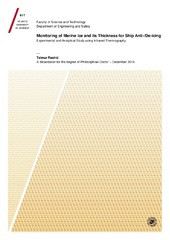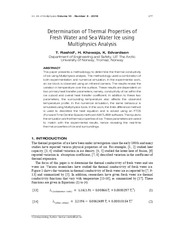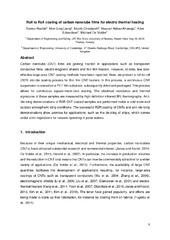| dc.contributor.advisor | Khawaja, Hassan A. | |
| dc.contributor.author | Rashid, Taimur | |
| dc.date.accessioned | 2019-04-17T09:13:41Z | |
| dc.date.available | 2019-04-17T09:13:41Z | |
| dc.date.issued | 2019-03-01 | |
| dc.description.abstract | Ships operating in a cold climate face many challenges. There are several associated risks such as safety concerns, down time, energy consumption and limited resources. Amongst the key challenges, ship ice accretion is significant for cold climate operations. Exposing superstructures to the marine icing phenomenon can affect the ship’s operations, risking the safety of humans and machines. In this regard, a set of mandatory guidelines, the International Code for Ships Operating in Polar Waters (Polar Code), was released in 2015 by the International Maritime Organization (IMO) and came into effect from 2017. Therefore, modern ships require a support system that can provide real-time information about the marine icing on different parts of the ship.
This study focuses on identifying, assessing and implementing a technique that could provide real-time information about marine ice accretion and its thickness on a surface in cold environmental conditions. In this regard, due to its particular advantages, such as non-contact measurement, area detection and the need for less observation time, infrared thermography (IRT) is used to remotely monitor the marine ice samples. Initially, the characterization of marine ice samples is performed using IRT, and experimental results are verified through numerical simulations, using a finite difference method (FDM). Thereafter, IRT is used to measure the thickness of marine ice samples when subjected to heating from underneath. The laboratory experiments are performed at controlled atmospheric conditions, and marine ice thickness up to 15mm is tested. Furthermore, an electrothermal coating material is manufactured for implementing large-scale anti-/de-icing. This is achieved by using a roll to roll (R2R) coating process of carbon nanotubes (CNTs). The coating is manufactured on a meter-scale poly(ethylene terephthalate) (PET) sheet. This R2R CNT coating is characterized and demonstrated for anti-/de-icing purposes.
The results of this study show that IRT can be used to measure the thermal properties of marine and pure ice. The effective values of thermal conductivity and overall heat transfer coefficient calculated using IRT for saline and pure ice samples agree with findings in the literature. A major finding of this study is that marine ice thickness has a strong correlation with the time taken to respond to the change in temperature, subject to heating being provided from underneath. It is also shown that marine ice thickness is empirically correlated with the rate of change of temperature and time to reach a certain temperature difference. Furthermore, a R2R CNT coating is successfully implemented on a meter-scale PET sheet, which shows linear current to voltage response. This electrothermal coating material can be used for anti-/de-icing of large surfaces. | en_US |
| dc.description.doctoraltype | ph.d. | en_US |
| dc.description.popularabstract | This study focuses on identifying, assessing and implementing a technique that could provide real-time information about marine ice accretion and its thickness on a surface in cold environmental conditions. In this regard, due to its particular advantages, such as non-contact measurement, area detection and the need for less observation time, infrared thermography (IRT) is used to remotely monitor the marine ice samples. IRT is used to measure the thickness of marine ice samples when subjected to heating from underneath. The laboratory experiments are performed at controlled atmospheric conditions, and marine ice thickness up to 15mm is tested. Furthermore, an electrothermal coating material is manufactured for implementing large-scale anti-/de-icing. This is achieved by using a roll to roll (R2R) coating process of carbon nanotubes (CNTs). The coating is manufactured on a meter-scale poly(ethylene terephthalate) (PET) sheet. This R2R CNT coating is characterized and demonstrated for anti-/de-icing purposes.
A major finding of this study is that marine ice thickness has a strong correlation with the time taken to respond to the change in temperature, subject to heating being provided from underneath. Furthermore, a R2R CNT coating is successfully implemented on a meter-scale PET sheet, which shows linear current to voltage response. This electrothermal coating material can be used for anti-/de-icing of large surfaces. | en_US |
| dc.description.sponsorship | Faroe petroleum | en_US |
| dc.identifier.isbn | 978-82-8236-336-5 (trykt) og 978-82-8236-337-2 (pdf) | |
| dc.identifier.uri | https://hdl.handle.net/10037/15215 | |
| dc.language.iso | eng | en_US |
| dc.publisher | UiT Norges arktiske universitet | en_US |
| dc.publisher | UiT The Arctic University of Norway | en_US |
| dc.relation.haspart | <p>Paper I: Rashid, T., Khawaja, H.A. & Edvardsen, K. (2016). Review of marine icing and anti-/de-icing systems. <i>Journal of Marine Engineering and Technology, 15</i>(2), 79-87. Publisher’s version not available in Munin due to publisher’s restrictions. Publisher’s version available at <a href=https://doi.org/10.1080/20464177.2016.1216734>https://doi.org/10.1080/20464177.2016.1216734</a>.
<p>Paper II: Rashid, T., Khawaja, H.A. & Edvardsen, K. (2016). Determination of Thermal Properties of Fresh Water and Sea Water Ice using Multiphysics Analysis. <i>International Journal of Multiphysics, 10</i>(3), 277-291. Also available at <a href=https://hdl.handle.net/10037/9748>https://hdl.handle.net/10037/9748</a>.
<p>Paper III: Rashid, T., Khawaja, H.A. & Edvardsen, K. (2019). Measuring thickness of marine ice using IR thermography. <i>Cold Regions Science and Technology, 158</i>, 221-229. Publisher’s version available at <a href=https://doi.org/10.1016/j.coldregions.2018.08.025>https://doi.org/10.1016/j.coldregions.2018.08.025</a>. Accepted manuscript version available at <a href=https://hdl.handle.net/10037/13664> https://hdl.handle.net/10037/13664</a>.
<p>Paper IV: Rashid, T., Liang, H.L., Chiodarelli, N., Khawaja, H.A., Edvardsen, K. & De Volder, M. Roll to Roll coating of carbon nanotube films for electro thermal heating. (Manuscript). | en_US |
| dc.relation.projectID | info:eu-repo/grantAgreement/RCN/NORDSATS/195153/Norway/ColdTech - Sustainable Cold Climate Technology/ColdTech/ | en_US |
| dc.rights.accessRights | openAccess | en_US |
| dc.rights.holder | Copyright 2019 The Author(s) | |
| dc.rights.uri | https://creativecommons.org/licenses/by-nc-sa/3.0 | en_US |
| dc.rights | Attribution-NonCommercial-ShareAlike 3.0 Unported (CC BY-NC-SA 3.0) | en_US |
| dc.subject | Anti-/de-icing | en_US |
| dc.subject | Marine ice | en_US |
| dc.subject | Infrared thermography (IRT) | en_US |
| dc.subject | Conductive heat transfer | en_US |
| dc.subject | Marine ice thickness | en_US |
| dc.subject | Cold climate | en_US |
| dc.subject | Ice detection | en_US |
| dc.subject | Carbon nanotubes (CNTs) | en_US |
| dc.subject | Electrothermal heating | en_US |
| dc.subject | Roll to roll (R2R) coating | en_US |
| dc.title | Monitoring of Marine Ice and its Thickness for Ship Anti-/De-icing - Experimental and Analytical Study using Infrared Thermography | en_US |
| dc.type | Doctoral thesis | en_US |
| dc.type | Doktorgradsavhandling | en_US |


 English
English norsk
norsk


